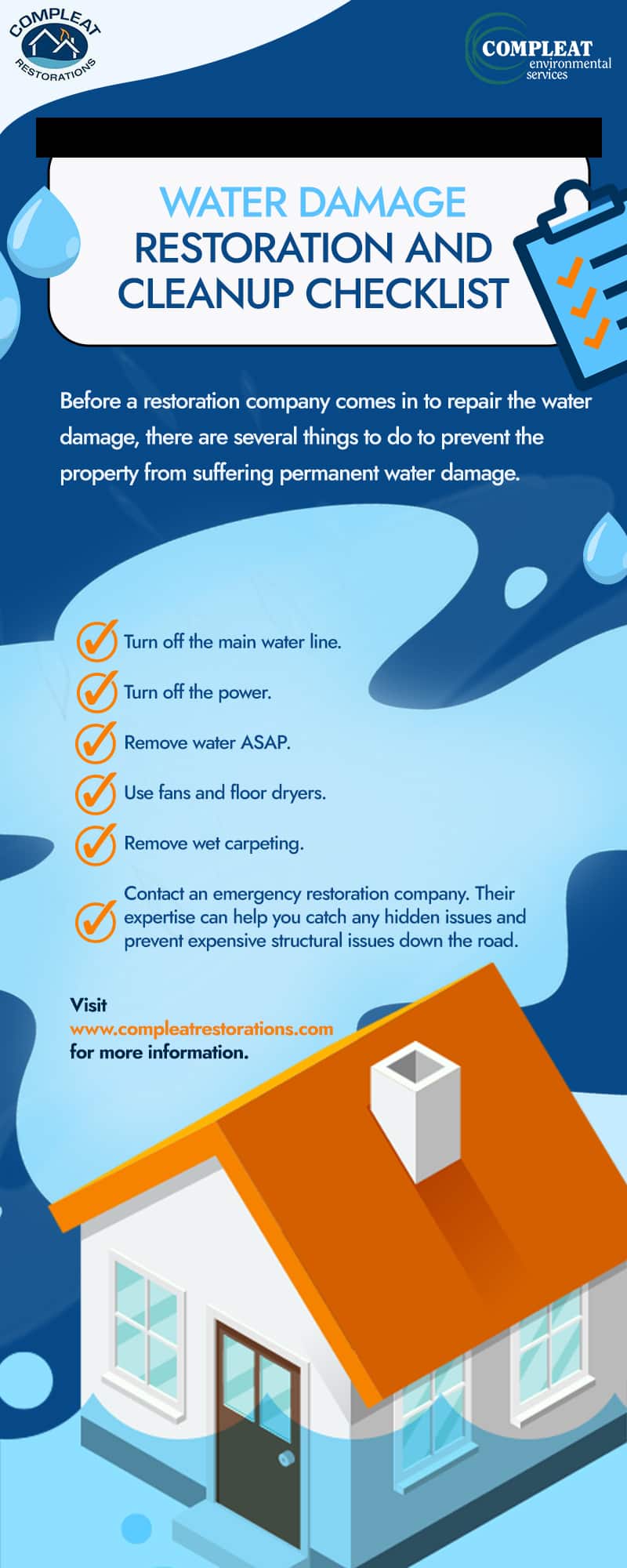When water damage occurs, whether it is from flooding, broken pipes, leaking appliances, or other causes, it is important to act before it is too late. The clock is ticking after water causes damage, so it is vital to think about water damage restoration as soon as possible. After water damage has happened, it takes little time for mold to develop, leading to safety hazards and structural problems. By the time these water damage problems are visible, it is too late.
Causes of Water Damage in Homes and Commercial Buildings
Water damage can come from a variety of sources, from flooding to sewer backups, and issues with roof integrity. When water seeps into places it should not be, it can cause floors to warp. Moreover, walls become discolored, and mold begins forming. Eventually, it can even cause the foundation of any building to be weakened if not properly addressed. Some of the most common causes of water damage in homes and commercial buildings are severe weather, clogged gutters, leaking pipes, washing machine water supply line leak, blocked drains, malfunctioning sprinkler systems, and a leaking water heater.
Thunderstorms and other natural disasters may not happen every day, but when they strike, fierce winds and a heavy downpour can send water straight into your home or business. Leaking pipes are another cause and could be anything from a loose-fitting pipe under the kitchen sink to a broken pipe inside the walls. A leaky washing machine water supply line could be a problem if your washing machine has rubber or PVC supply lines. Blocked drains in a kitchen sink, bathroom floor, or bathtub could quickly cause flooding eventually.
Malfunctioning sprinkler systems can turn themselves on even if a fire is not present, causing electrical appliance damage throughout the property. Finally, a leaking water heater can occur if it is old, poorly maintained, or not installed properly. These occurrences are all too common and cause water damage in both houses and businesses. While many variables go into minimizing water damage that can happen, paying attention to these areas can help to prevent water damage, and the home restoration repairs it requires, in the future.
How does Water Damage Restoration Work?
When work begins to restore water damage, the first step is to inspect the property, take moisture metering, and use infrared cameras to determine the extent of the damage. This inspection determines the water damage class and category, creates a restoration plan, explains the process to you and answers any questions, and finally works with your insurance company to cover the associated costs.
After the complete inspection, water extraction occurs to halt the water damage. Next, the area is dried out. Finally, the water-damaged household belongings are restored, and those eligible for insurance replacement claims are filed. Restorable items are then stabilized and dried and non-damaged items are protected. This process is the same, from the smallest water leak to large-scale flood damage. For businesses with commercial water damage, the goal is to respond quickly, stabilize the property, conduct the inspection, restore building contents, extract water, prevent mold, and finally monitor the progress of the restoration.
Actions to Take Before a Restoration Company Comes In
Before a restoration company comes in to repair the water damage, there are several things to do to prevent the property from suffering permanent water damage. As mold can start within 24 to 48 hours, it is important to follow these tips to prevent permanent water damage by acting quickly.
- Turn off the main water line. Turning off the water in your home helps to minimize flooding.
- Turn off the power. This can help to remove electrical hazards in standing water.
- Remove water ASAP. Removing water using a sump pump or dehumidifier is an important first step.
- Use fans and floor dryers. After electricity is back, use standing and box fans to speed up drying.
- Remove wet carpeting. If area rugs or pads are present, remove them to speed up the drying process.
- Contact an emergency restoration company. Avoid attempting to repair water damage on your own. Instead, contact a https://compleatrestorations.com water damage restoration specialist to clean and dry your property and restore it to its former condition. Their expertise can help you catch any hidden issues and prevent expensive structural issues down the road.
Results of Water Damage Restoration
The results of water damage restoration are to restore your property to the state of being it was in before the water damage occurred. By using a professional restoration service, you will have access to the equipment necessary to restore the interior and exterior of the structure to its former glory. Home and commercial property owners depend on water damage restoration to eliminate every trace of damage as quickly as possible. A restoration company can also work with your insurance company. It is to aid in filing claims and ensuring a smooth process from beginning to end. The goal is to restore it to its pre-water damage state and prevent damage and mold from growing.
If you have experienced water or flood damage on your property, please contact Compleat Restorations. Compleat Restorations is here for you 24 hours a day, 365 days a year. We have the capability to respond within 2 hours onsite. Included is the set up of a mobile command center, and assistance with insurance claims. Our goal is to secure and stabilize your building as quickly and safely as possible. From there wi will begin the water damage restoration process. We have the expertise to find hidden water damage and rebuild the property to its pre-water damage state.


